Common menu bar links
Table of Contents - Previous - Next -
Archived -
Annex 1
This Web page has been archived on the Web.
Fiscal Performance of Canada's Federal-Provincial-Territorial Government Sector
Summary
- This annex presents the fiscal situation of the aggregate federal-provincial-territorial government sector in Canada based on Public Accounts data, as published by the individual governments.[1]
- The federal government posted a surplus of $13.2 billion in 2005–06, while the provincial-territorial governments recorded an equivalent surplus, for a combined federal-provincial-territorial surplus of $26.4 billion. All 13 provincial-territorial jurisdictions posted surpluses in 2005–06, the first time this has occurred in the 60 years that historical data has been available.
- For 2006–07, the federal government is projecting a $9.2-billion surplus. Based on the latest available data,[2] the provincial-territorial sector is forecasting a surplus of $8 billion in 2006–07. If the $1.3 billion in contingency reserves currently included in provincial government budget plans are removed, the provincial-territorial sector surplus would be $9.3 billion.
- While the federal revenue-to-GDP (gross domestic product) ratio continued to decline in 2005–06, the provincial-territorial revenue-to-GDP ratio continued to increase, supported by strong natural resource revenues and higher federal transfers. In 2006–07, lower expected natural resource revenues are expected to contribute to a somewhat lower provincial-territorial revenue-to-GDP ratio. The federal revenue-to-GDP ratio is expected to continue its downward trend, falling to 16.1 per cent in 2006–07, compared to 18.1 per cent at the provincial-territorial level.
- In 2006–07, provincial-territorial program spending as a share of GDP is expected to increase to 15.9 per cent, reflecting increased spending, notably in the area of health care. At the federal level, program spending as a share of GDP is expected to increase by 0.3 percentage points to 13.1 per cent, after declining by 0.9 percentage points in 2005–06.
- The provincial-territorial debt-to-GDP ratio is expected to fall to 19.6 per cent in 2006–07, compared to 32.8 per cent at the federal level. Reflecting this higher debt burden, the federal government continues to face much higher debt charges than the provincial-territorial sector.
The fiscal position of the federal and provincial-territorial governments remains strong
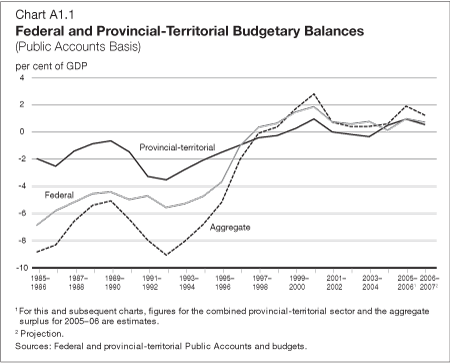
- Both the federal and provincial-territorial governments remain in a strong fiscal position. For both the federal and provincial-territorial governments, spending control during the mid-1990s and strong economic growth have turned large deficits into an unprecedented period of sustained surpluses.
- In 2005–06, the federal government recorded a surplus of $13.2 billion or 1 per cent of GDP, representing the ninth consecutive budget surplus, which is a considerable improvement relative to the previous two decades. Similarly, the combined provincial-territorial governments recorded a surplus of $13.2 billion or 1 per cent of GDP in 2005–06, the largest absolute provincial-territorial surplus ever.
- In 2006–07, the federal government is projecting a $9.2-billion surplus, representing 0.6 per cent of GDP, while the provincial-territorial sector is forecasting a surplus of $8 billion or 0.6 per cent of GDP, the sixth surplus in the past eight years. If the $1.3 billion in contingency reserves currently included in provincial government budget plans are removed, the provincial-territorial sector surplus for 2006–07 would be $9.3 billion.
All provincial-territorial governments were in surplus in 2005–06
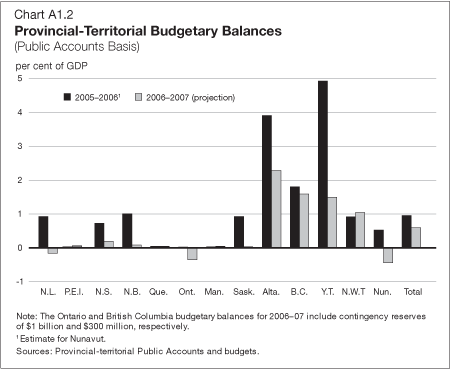
- All provincial-territorial governments posted surpluses in 2005–06, the first time this has occurred in the last 60 years. Most governments benefited from strong revenue growth, in part reflecting a surge in natural resource revenues in several provinces, coupled with a significant fiscal improvement in Ontario.
- Ten of the 13 jurisdictions expect surpluses in 2006–07. These surpluses are generally forecast to be smaller than in 2005–06, reflecting the impact of the slowdown of the U.S. economy and lower oil and gas prices.
The gap between federal and provincial-territorial revenues is widening…
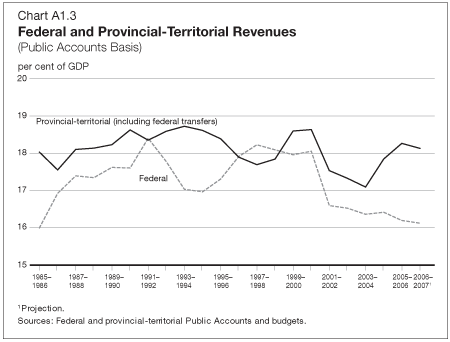
- Provincial-territorial revenues (including federal transfers such as Equalization and the Canada Health Transfer) continue to exceed federal revenues. The gap has widened in recent years as a result of federal tax relief and the impact of growing federal transfers and higher energy prices on provincial-territorial revenues.
- In 2000–01, provincial-territorial revenues stood at 18.6 per cent of GDP, compared to 18.1 per cent at the federal level. Federal revenues as a share of GDP are expected to decline to 16.1 per cent in 2006–07. This mainly reflects cuts in personal and corporate income taxes at the federal level and the 1-per-cent reduction in the goods and services tax rate.
- Provincial-territorial revenues are forecast to decline to 18.1 per cent of GDP in 2006–07, a reduction of 0.5 percentage points since 2000–01. As a result, in 2006–07, provincial-territorial revenues are expected to be 2.0 percentage points of GDP (or nearly $29 billion) higher than the federal government’s revenues, compared to a gap of just 0.5 percentage points in 2000–01. The gap between federal and provincial-territorial revenues will likely continue to grow over the coming years, which reflects the increased transfers to provinces and territories as a result of the Government’s plan to restore fiscal balance through, for example, Equalization, the Canada Social Transfer and Territorial Formula Financing.
…while the gap between federal and provincial-territorial program spending remains stable
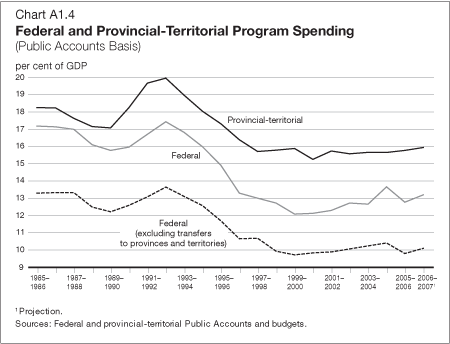
- As a share of GDP, program spending for both orders of government has fallen sharply since the early 1990s, with a somewhat larger decline at the federal level.
- Since 2000–01, program spending as a percentage of GDP has risen for both orders of government but remains substantially below the peak of the early 1990s.
- At the federal level, one of the main drivers of program spending growth has been cash transfers to the provinces and territories, while provincial-territorial program spending growth has mainly been related to health care.
- Federal program spending as a share of GDP fell significantly in 2005–06, the first decline since 1999–2000. Going forward, the Government is committed to maintaining the growth in program spending, on average, below the growth in the economy.
- In 2006–07, provincial-territorial program spending as a share of GDP is expected to increase to 15.9 per cent, reflecting increased spending, notably in the area of health care. At the federal level, program spending as a share of GDP is expected to increase by 0.3 percentage points to 13.1 per cent, after declining by 0.9 percentage points in 2005–06.
Federal and provincial-territorial debt burdens continue to decline…
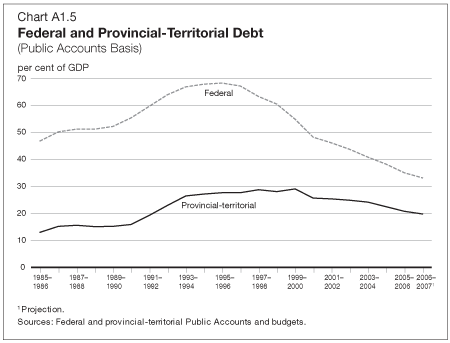
- As a result of their improved fiscal situations, the provincial-territorial and federal governments have made significant progress in reducing their debt burdens.
- The provincial-territorial debt-to-GDP ratio is expected to fall to 19.6 per cent in 2006–07, a decline of 9.4 percentage points from its peak of 29.1 per cent in 1999–2000.
- The federal debt-to-GDP ratio is expected to fall to 32.8 per cent in 2006–07. Although it is significantly lower than its peak of 68.4 per cent in 1995–96, it remains higher than the combined provincial-territorial debt-to-GDP ratio. The Government remains on track to reduce the federal debt to 25 per cent of GDP by 2012–13.
…resulting in a steep decline in debt charges as a share of total revenues
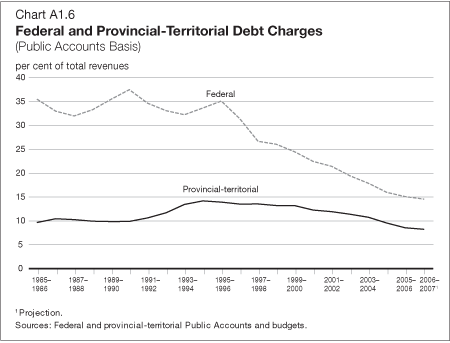
- Reflecting a reduction in public debt and lower interest rates, the federal and provincial-territorial governments are spending less of their revenues on debt-service costs.
- At the peak in 1990–91, 37.6 cents of each federal revenue dollar went to service the federal debt. This ratio is expected to fall to 14.7 cents in 2006–07, the lowest level since the late 1970s.
- Provincial-territorial governments continue to face much lower debt charges than the federal government. In 2006–07, they are expected to spend 8.4 cents of each revenue dollar for debt-service costs.
1 Does not include the financial activities of local governments, the Canada Pension Plan (CPP) and the Quebec Pension Plan (QPP). The performance of the total government sector, which includes both local governments and the CPP/QPP, is presented in Annex 2. [Return]
2 Data available up to February 27, 2007. [Return]
Table of Contents - Previous - Next -
